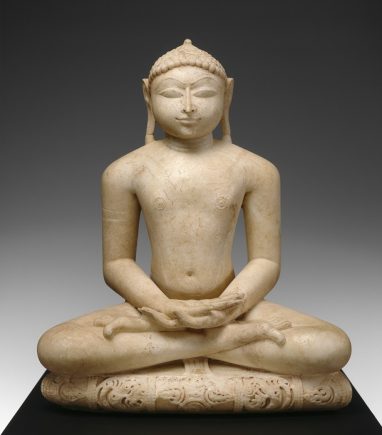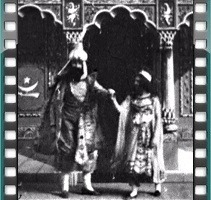October 19, 2013–January 26, 2014
-
Dates
-
Location
Arthur M. Sackler Gallery
-
Collection Area
South Asian & Himalayan Art
Yoga is a global phenomenon practiced by millions of people seeking spiritual insight and better health. Few, however, are aware of yoga’s dynamic history. Opening this fall at the Smithsonian’s Arthur M. Sackler Gallery is Yoga: The Art of Transformation, the world’s first exhibition of yogic art. Temple sculptures, devotional icons, vibrant manuscripts, and court paintings created in India over 2,000 years—as well as early modern photographs, books, and films—reveal yoga’s mysteries and illuminate its profound meanings.
The exhibition borrows from twenty-five museums and private collections in India, Europe, and the United States. Highlights include an installation that reunites for the first time three monumental stone yogini goddesses from a tenth-century Chola temple; ten folios from the first illustrated compilation of asanas (yogic postures), made for a Mughal emperor in 1602, which have never before been exhibited together; and Thomas Edison’s Hindoo Fakir (1906), the first movie ever produced about India.
Through masterpieces of Indian sculpture and painting, Yoga: The Art of Transformation explores yoga’s rich diversity and historical transformations, including its philosophies, transformational goals, and importance within multiple religions. The exhibition also examines the varied roles that yogis and yoginis played in society, from sages to spies.
Yoga: The Art of Transformation is organized by the Arthur M. Sackler Gallery, Smithsonian Institution. Generous support for the exhibition is provided by the Friends of Freer|Sackler, Whole Foods Market, Art Mentor Foundation Lucerne, The Alec Baldwin Foundation, Chandrika and Ranjan Tandon, The Ebrahimi Family Foundation, Nancy and Hart Fessenden, May Liang and James Lintott, Susan and Michael Pillsbury, Mrs. Arthur M. Sackler, Catherine Glynn Benkaim and Barbara Timmer, IndiaTourism, the Together We’re One crowdfunding campaign, and media sponsor Yoga Journal.

Introduction
Yoga: The Art of Transformation explores a largely untapped resource—visual culture—to illuminate both central aspects of yoga practice and its hidden histories. Many people are aware of yoga’s origins in India, and the discipline is widely recognized around the world as a source of health and spiritual insight. But the aspirations that compelled countless individuals to pursue yogic paths and are little known outside of scholarly and advanced practitioner circles. Even fewer are familiar with yoga’s rich diversity—its varied meanings for practitioners and for those they encountered.
Yoga is the first exhibition to survey this leitmotif of Indian culture. The exhibition’s 133 works, which were created over two millennia, range from devotional sculptures and illustrated court manuscripts to colonial photographs and early films. They shed light on yoga’s meanings and philosophical depth, the practice’s centrality within Indian culture and religion, its movements over time and across communities, and the genius of artists who transformed profound concepts into material form.
Arthur M. Sackler Gallery
October 19, 2013–January 26, 2014
Asian Art Museum of San Francisco
February 21–May 25, 2014
Cleveland Museum of Art
June 22–September 7, 2014
Gallery
The Ocean of Life
Bahr al-hayat (Ocean of Life)
India, Uttar Pradesh, Allahabad
1600–1604
The Trustees of the Chester Beatty Library, Dublin
Because gurus traditionally taught yoga orally and directly to their disciples, Hindu treatises only tersely describe asanas. The earliest extant manuscript with illustrated asanas, the Ocean of Life (Bahr al-hayat), dates from the turn of the seventeenth century.
None of its asanas are taught in any earlier Sanskrit text, and their descriptions are more detailed than those in other Sanskrit treatises written over the next century. The illustrated treatise was produced in the context of an Indo-Islamic court. It is one of three yoga-related manuscripts commissioned by Prince Salim (the future Mughal Emperor Jahangir) in Allahabad between 1600 and 1604.
The Persian text of Ocean of Life was composed in Gujarat around 1550 by Muhammad Ghwath Gwaliori, a prominent Sufi spiritual master. Ghwath’s goal was to teach his disciples hatha practices compatible with Sufi goals of spiritual transformation. Based on both earlier Sanskrit treatises and conversations with living yogis, the text demonstrates how yoga was made familiar to Sufi ascetics.
Chapter 4 of the Bahr al-hayat, by Muhammad Ghawth Gwaliyari
Translated from the Persian by Carl W. Ernst
Copyright © 2013; not to be reproduced without permission
The text that follows is a working translation of chapter 4 of the Bahr al-hayat, by Muhammad Ghawth Gwaliyari, a text describing the practices of yoga
as seen by a sixteenth-century India Sufi. For the larger context in which this translation was composed, see the articles on my website at
http://www.unc.edu/~cernst/articles.htm, in section 3, on Indo-Muslim culture.
This translation is based on a comparison of seven manuscripts; there are another dozen or so manuscript copies to which I did not have access. Variations between these copies are indicated in notes by reference to manuscript symbols, and the full information for each copy is indicated in the list below.
- Per1A. India Office, 2002 Ethé, British Library, London. 165 pages, missing parts of chapters III and IX and all of chapter X. Marginal notations of Hindi terms in Devanagari script. See Hermann Ethé, Catalogue of Persian Manuscripts in the India Office Library (Oxford: India Office, 1903; reprint ed., London: India Office Library & Records, 1980), cols. 1113-14, no. 2002.
- Per1B. Ganj Bakhsh 6298, Islamabad. Identified in the catalogue only as an anonymous Risala-i `irfan (Treatise on Mysticism). 112 pages bound out of order, missing the first few pages of the introduction (corresponding to Per1A, pp. 1-6) and the end of the conclusion. Contains date of 6 Sha`ban 1279 (26 January 1863) in marginal note at colophon on p. 26. See Ahmad Munzawi, Fihrist-i Mushtarak-i Nuskha-ha-yi Khatti-i Farsi-i Pakistan (Islamabad: Markazi-i Tahqiqat-i Farsi-i Iran wa Pakistan, 1363/1405/1984), 3:1488, title no. 2695, MS no. 8032.
- Per1C. Pir Muhammad Shah Library, Ahmedabad. Labelled Hawd al-hayat on obverse of first page, 33 fols., ending in the middle of chapter IV. See Muhammad Zuber Qureshi, “The Library of Hazrat Pir Muhammad Shah at Ahmedabad,” in Islam in India: Studies and Commentaries, vol. 2, Religion and Religious Education, ed. Christian W. Troll (New Delhi: Vikas Publishing House Pvt Ltd, 1985), p. 295, no. 39.
- Per1D. Chester Beatty Library, Dublin. 64 fols. with some damage, illustrated with 21 miniatures of yogic postures from chapter IV, early eleventh/seventeenth century. See Thomas A. Arnold, The Library of A. Chester Beatty: A Catalogue of the Indian Miniatures, rev. and ed. J. V. S. Wilkinson, (London: Oxford University Press, 1936), I, 80-82 (no. 16); III, 98 (2 illus.); Linda Leach, Mughal and other Indian paintings from the Chester Beatty Library (London: Scorpion Cavendish, 1995), 2:556-564.
- Per1J. Liyaqat Memorial Library, Islamabad, 46 (now in National Library of Pakistan, Karachi). 68 fols., with extensive marginal notes on fols. 1-10. Classified under charms (ad`iya). See Munzawi, 4:2146, title no. 3890, MS 11628.
- Per1T. India Office, Ashburner 197. 147 pages. See E. Denison Ross and Edward G. Browne, Catalogue of Two Collections of Persian and Arabic Manuscripts Preserved in the India Office Library (London: Eyre and Spottiswode, 1902), p. 116.
- Per1X. University of North Carolina at Chapel Hill, Rare Book Collection, 123 pages, copy dated 1130/1718, containing twenty-one miniatures similar to those in Per1D. See Manuscripts from the Himalayas and the Indian Subcontinent, Catalog 17 (London: Sam Fogg Rare Books and Manuscripts, 1996), p. 157.
- Know that the wisdom of the human body rests upon water, and its basis and structure is upon earth. Existence, constitution, contraction, and expansion, are by the power of fire, while height, fancy, motion, power, fate, and respiration are by the perception of air. General comprehension, particular substance, human logic, familiar understanding, the discernment of reality, and the infused spirit are from the emanation of “God is the light of the heavens and the earth” (Qur’an 24:35). Since for these mentioned things the overt manifestation of the existence of wisdom is not uniform, the orbit of the microcosm raises its head, becoming prepared and existent, and skin, flesh, blood, bone, vein, foot, and face become existent by the substance of the macrocosm. It makes known the motion, articulation, and rest of the macrocosm, for all of the heavens and planets exist by the daily motion of the throne in one day. When that circle settles, the microcosm becomes superfluous. The planet of earth, which is the center of the heavenly spheres, in a short time becomes a scattered mote of dust. Therefore the divine creator has, with wisdom and power, given them a craft that connects them, so that one cannot overcome another. Thus is the macrocosm established. Wherever with the very same wisdom the microcosm sets its basis and structure on that, it exercises with acquisition, discipline, strategem, and wisdom, until without custom it becomes customary, so that the microcosm is not confounded. As is the one, so is the other; let it be revealed!
- The body is like a country, and the spirit is like the king. When the country is ruined, the king departs. When it is sound, he rules with insight, instruction, and sagacity. He makes it flourish; it flourishes in a special sense. Fundamentally, devastation, lack, and regret do not appear. But when the far-seeing eye is afflicted by the desire of forgetfulness, the longing for encounter, and the taste for sweet and salt, and it finds that state overwhelming, it must go forth from itself. But since there is no protection, because God has said, “One given wisdom has been given much good” (Qur’an 2:269), if an affair turns out well without wisdom, the name “The Wise” is useless. Since by his grace the transcendant Creator has brought you from nonexistence to existence and made you existent, you should not throw yourself to the wind or consider yourself vain and fanciful. Therefore treat your body with discipline, maintain your thought with internal concentration, and moderate your ardor. When you raise the flag of greatness, this existence essentially has no motion, except by the heart, for the heart is the demonstration of the Merciful and the grace of the Lord. When they bring this out from the veil of the other, it is commanded by the order of the primordial command. By the command of God most high it is assisted and made eternal, dominating with total comprehensiveness. No deception or covering veils it. With every breath and step, advancing manifestations appear, outwardly acquired but internally given.
- In short, this body is like a leather bag (anbān) full of water, or a sheep-skin (mashk) full of air. If that water or air settles, shrinkage must occur. When this body has become full of air and water, action is not possible except by strategem (ḥīla), and the strategem is the purification of the body by gentleness, so no harm reaches it and it is not destroyed. When in the mother’s womb the child once obtains grace (fayḍ), and with it arrives to its strength and form of life, if every time it obtains the same quantity of grace, the same quantity of life is established. But in this there is a condition, that one should attract that water and air by acquisition and discipline, to become powerful over the body. Then one conveys the subtle to the ideal (mithāl), and one transforms the gross into the form of the ideal. Whatever is not suitable one removes and rejects. Every time, one does the same; purity of the body is produced by the posture. In all, the postures are 84, and each one has a special quality and benefit, with thought. In this book twenty-one postures will be explained, and their goal will be obtained, by the aid of the transcendant Creator. The condition of this practice is that in the beginning one chooses fasting and seclusion, while abstaining from gazing [at improper things]. When one encounters a kind of difficulty at the beginning of the exertion (mujāhada), one does not worry or deviate, but remains busy with the activity. The time of exertion is like winter, and its conclusion is the rainy season and spring. For practice by day and night one picks a particular time.

- The recollection (dhikr) of hans [no. 1], that is, the first spiritual state of the Jogis; they teach this practice to their students, and in this generosity appears. In their technical terms they call recollection (dhikr) practice (karma), and they call asceticism and abstemiousness dharma. Their piety (taqwa) is to become separated from attachments and impediments, with an ascetic’s rag (zhinda) on the breast, a covering (fūṭa) on the waist, dust scattered on the head, and face smeared with ash – they are distinguished from the people of the world. From nothingness they see the whole of existence, they have grasped the thread of unity from end to end, internal and external have a single meaning, imagination, thought, and concept have taken on a single form, and with all peaceful beauty, whatever comes from the beloved is worthy, and one understands the posture. The posture of this practice (karma) they call sahaj āsana; let it be unveiled! One holds the head, waist, and back even, and one meditates, placing one shin over the other, holding the left ankle under the point of the right knee, and placing the right ankle under the point of the left knee, clasping both hands together. When exhaling, one says hans, and hans is an expression for “the spiritual Lord” (Ar. rabb rūḥī). When inhaling, one says so ham, and so ham is the expression for “Lord of Lords” (Ar. rabb al-arbāb). When the spiritual Lord takes the form of the Lord of Lords, a single manifestation becomes apparent with every beauty. It becomes the locus of witnessing, unveiling, and vision. Most people need to persist in this recollection (dhikr), to open the door to the hidden of the hidden.The goal1 of the spiritual state of this point is this.2
1 Instead of “goal” (intihā’), some MSS have “witnessing” or “testimony” (ishhād), a term that is formulaically repeated at the end of several descriptions of postures.
2 Per1A adds on the margin a Hindi dohra in devanagari script, alakh niranjan lakhe na koy, jyun lakhe tora he na soy.

- The word of recollection (dhikr)3 of alakh [no. 2]4. When one wishes to do this practice (karma), one assumes the posture sitting on both knees, with the left hand clenched in a fist, placing that fist on the right kneecap. One holds the right elbow over the fist. One also clenches the right hand into a fist, leaning on the chin, and tightening up the buttocks (surīn). One brings the navel toward the back. One brings the breath upward from beneath the navel, which is the house of fire. One brings it up to the brain in the form of alakh, and alakh is an expression for the pure (buḥt),5 until one is lost in that imagination, so that no information of the state remains. The testimony of this spiritual state is this.
3 The text systematically introduces each practice by juxtaposing the Hindi term shabda or “word” with Arabic dhikr or recollection; although both refer primarily to practices of oral recitation, they function here as synecdoches for yoga postures. Several MSS indicate a failure to understand this pairing technique. Per1J regularly replaces shabda with Ar. sanad, “document.”
4 UNC: alakh dhyan.
5 So Per1B. Other readings: “fortune” (bakht), “throne” (takht), “speech” (sukhan).

- The word of recollection of kahkī [no. 3]. When the meditator (dhākir) wants to do this practice, he should sit in the karbat posture.6 Karbat is the expression for the sitting position of the turtle. The turtle has two manners of sitting. In the first, gathering the hand and foot and head to oneself, one sits in forgetfulness of oneself. Here the posture is not the goal; the goal is a uniform (yik-jinsī) posture. With the left foot on one knee, and the sole of the left foot placed beneath the buttocks, one holds the right knee straight and attaches the toes of the left foot to the right heel, and places the right hand on the right knee and the left hand on the left knee. Then one goes from the right knee, saying, “hī hī,” to the left knee, but one doesn’t bow the head. One tilts the shoulder blade a little and then straightens it. One does this firmly so the veins of the neck stand out, with the lips separated by a finger’s breadth and the teeth tightly clenched. One inhales firmly from the breast and exhales firmly, until one departs from oneself and reaches the Real (haqq).
6 Also karpat, karanba, karīna; this may be Hindi karwaṭ, “lying on one side,” though the reference to the turtle (Persian bākha) suggests the kurma āsana.
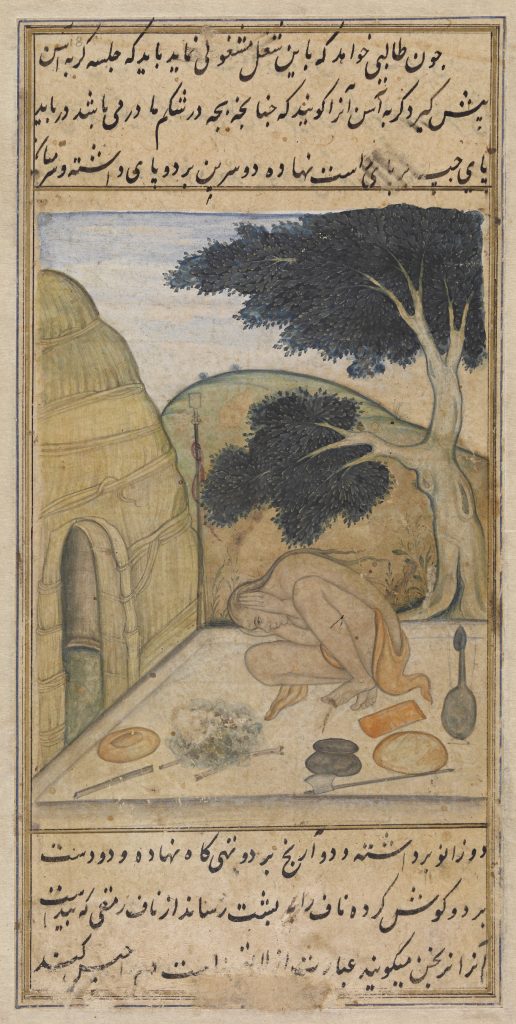
- The word of recollection of niranjan [no. 4]. When the seeker wishes to perform this activity,7 he should learn the garbha āsana.8 They call it the gharba āsana because when the child is in the womb of the mother it accomplishes it. One places the left foot on the right foot, holding the buttocks on both feet, holding the head evenly between the two knees,9 placing both elbows under the ribs, putting the hands over the ears, bringing the navel toward the spine. The breath of life (Ar. ramq) that appears from the navel they call niranjan, which is an expression for the undifferentiated (lā ta`ayyun). One holds the breath; one brings it in the midst of the belly. One takes it above from below, and below from above, in this exercise to such a degree that the inner eye, winged imagination, wandering reflection, and incomparable thought — all four — emerge from their restrictions. They enter witnessing of the spiritual state and become one.
7 Here Per1T inserts a Hindi dohra verse, jo tan chhari so tan bhavi gorakh par kahna namri.
8 Hindi gharba means “embryo.” Per1D has gurba, Persian for “cat.”
9 Per1B has “thigh” (rān) instead of “knee” (zānū).

- The word of recollection of chakrī [no. 5]. When one wants to see the entire world in a dot, and to find the entire world by the renewal of images in absolute existence, one should undertake the chakrī practice as a personal duty. Chakrī is an expression for turning. It is the brightness and luminosity of the eye in separation. When one performs this recollection, the dot that is visible one sees as a single point and the world appears as a single atom because it is the center of the circle. Quickly one sits with knees crossed and one hand placed on another. One keeps the seat even and turns the eye in all directions. After one year, the eye rotates; vision becomes concentrated upon its own state. The usefulness of this is considerable; after practice, it will become clear.

- The word of recollection of bunawlī [no. 6]. When the wayfarer wants to perform the bunawlī practice,10 first he sits in the cross-legged (chahār zānū) posture, holding both hands on top of both knees, holding the head, stomach, and back even. One leaves the navel in its own state and brings both the ingalā and pingalā into motion, like someone who is swift in weaving a garment. Ingalā is an expression for the sun, and pingalā is an expression for moonlight. When both are in orbit,11 perpetual motion occurs. The usefulness of this is grasped in this evidence.
10 Per1B in a marginal note adds, “The meaning of bunawlī, the external of that, is by weaving, but God knows best.” The term is obscure; the closest Hindi equivalent, binaulī, appears to mean cotton seed (Platts).
11 “Are in orbit” (kurra shavand), Per1B, Per1X, Per1J; “are shattered” (pārcha karda shavad), Per1T.
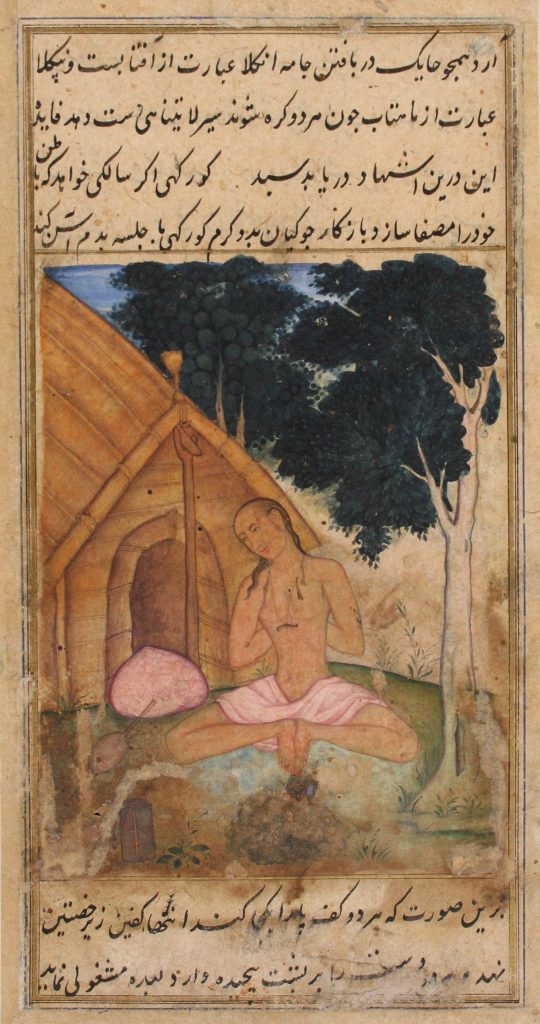
- The word of recollection of gorakhī [no. 7]. If the wayfarer wants to purify his interior, with the recollections (adhkār) of the Jogis he performs the gorakhī practice with the posture of the padma āsana, in this form. He brings the soles of both feet together, placing the tips of the feet beneath the genitals. He twists the hands behind the back, and then meditates. He tilts the head slightly and agitates the body a little. Evenly, he holds the breath of the tongue tightly to the teeth. From time to time he shuts his eyes.12 As soon as he forcefully exhales by the nostrils with complete effort, he inhales two such [breaths]. With difficulty he completes this and does it in succession. After dawn and after midday, the benefit of this activity will be revealed.13
12 This sentence is missing in Per1D, Per1X.
13 “Dawn” (fajr) and “midday” (`aṣr) are Arabic terms for the times of two of the five ritual prayers incumbent on Muslims.
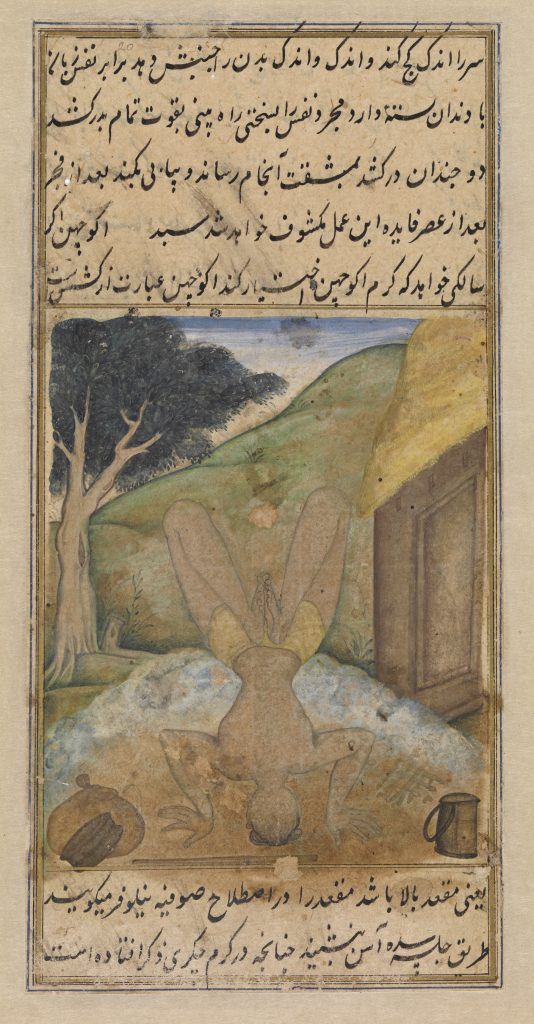
- The word of recollection of akūnchan [no. 8]. 14 If the wayfarer wants to choose the akūnchan practice, akūnchan is the expression for pulling, that is, the seat goes up [i.e., one is upside down]. In Sufi terminology they call this the water-lily (nīlūfar). One sits in the manner of the siddha āsana, just as occurs in the practice of the khēcharī recollection.15 The water-lily is the house of fire, and the place where the breath comes out. One holds the buttocks firmly together and pulls the water-lily up by the feet. A kind of fire appears that burns up all impurities. All unaccustomed food will turn to ash. It makes known the usefulness of this witnessing.
14 The nearest Hindi equivalent is akincan, “poverty” (Platts).
15 Some MSS have here the chakrī dhikr.

- The recollection of anahad [no. 9].16 When the wayfarer wants to be continually occupied with a single presence, but essentially has no time at his disposal, he should perform the anahad practice. They call anahad that which is of the eternal. One sits on both knees, holding the buttocks on the soles of the feet. One places the hands even with the ears, inserting both index fingers into the ears, with the thumb (nar-angusht) behind the ears, and the other three fingers spread out evenly, to the point that a sound arises. In this sound is the sign without a sign, perpetually. When one can no longer hold the hands up, one takes round pepper grain (filfil gird) and performs the posture, throwing it into fresh cotton and placing the cotton into each ear, so that the voice arises from the finger. By holding the cotton it will arise even so; the mystical adepts act so that, expecting that time, the fruits of this are more plentiful. This will become clear in practice.
16 Hindi anāhata (“unstruck”) refers to sound experienced without physical medium. The Persian spelling anahad may be influenced, one guesses, by the name of the ancient Iranian goddess Anāhita (New Persian Anāhīd, Nāhīd). Per1B consistently spells this term as anahad ṣabda, evidently substituting the Arabic letter ṣād for shīn in what would have been shabda, Hindi for “word,” here standing in for nād, “sound.” Per1A spells this as anḥad or abjad sabda, Arabicizing the first of the two words instead of the second.
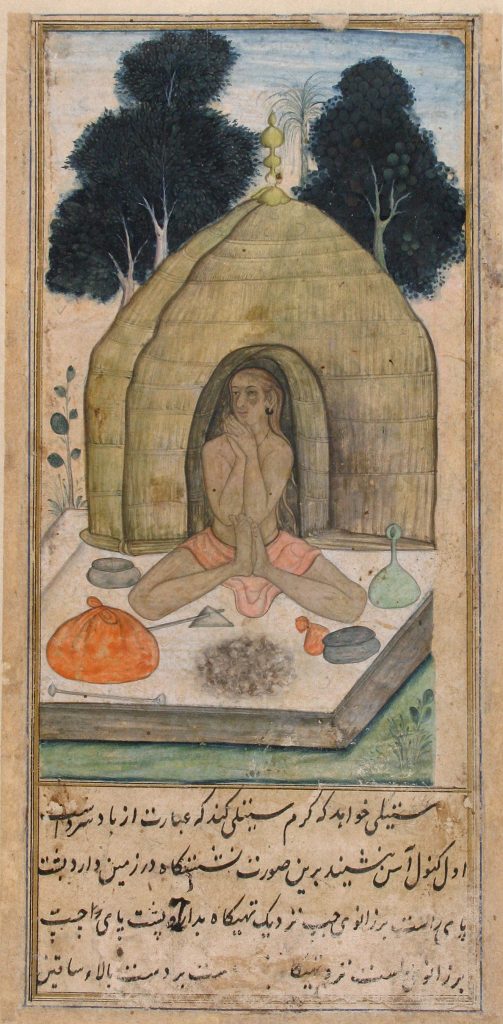
- The word of recollection of nād [no. 10].17 When someone wants to practice the nād, first one should sit cross-legged, holding the head, stomach, and back straight. Keeping both hands upright, joining the two thumbs together, one holds the elbows below, and places both elbows on the stomach over the navel. One takes one’s thought to the base of the brain. Now the base of the brain is a window that the Jogis call brahmarandhra. In that enters the window of the place of life, death, sleep, the settled abode of manifestation, the determination of the source of the essence, and the heaven of life, so that it is the testimony of the state of this word.
17 Clearly spelled as nād (Hindi “voice”) in devanagari (Per1A margin), this is mostly muddled in Persian script as the meaningless naṣbad.
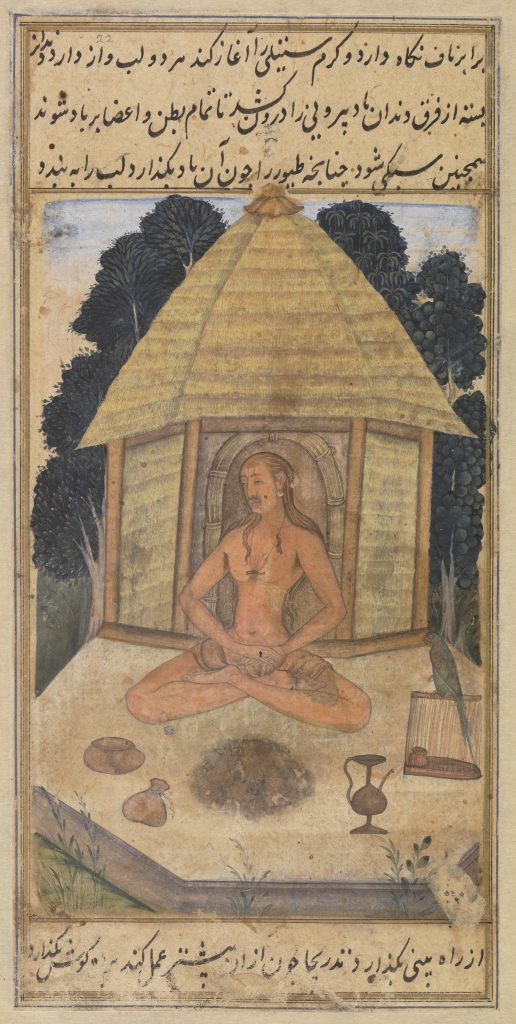
- The word of recollection of sītalī [no. 11]. When one wants to perform the sītalī practice, sītalī is the expression for cold air. First one sits in the lotus position (kanwal āsana), in this form, holding the seat on ground, and the back of the right foot on the left knee near the ribs, and placing the back of the left foot on the right knee near the ribs. One holds one hand over the other above the shins, even with the navel, and one begins the sītalī posture. One holds the lips apart with the teeth clenched, and one inhales the external air through the gap in the teeth, until the entire interior and limbs are full of air. Thus one becomes light, just like birds, when the wind releases them. One closes the lips and releases the air out by way of the nostrils. When one has performed much of that, one releases by way of the eye, gradually. When one has performed much of that, one releases by way of the ear, not permitting it by way of the nostril and mouth. When one is able, when one wishes to cleanse the stomach, one releases by way of the extremities. The benefits of this are limitless.

- The word of recollection of bhuvangam [no. 12]. When one wishes to perform the bhuvangam practice — and bhuvangam is the expression for the serpent (mār) — just as the serpent inhales, the wayfarer must act according to this path and comprehend it. He sits on both knees, holding the mouth closed; he inhales by way of the nostrils, taking it beneath the navel,18 bringing it up from the navel by force to the base of the brain. From there, gradually one releases it, and it reaches below the navel. Again one brings up by force, and one repeats this in this manner, as long as one is able. One holds the breath that was mentioned, not letting it go out by way of the nostril and mouth. When one is no longer able [to hold it], one lets out the breath by way of the nostrils with a loud voice,19 again from the top, and just as is mentioned, one begins [again]. Some practitioners carry this subtle practice to such an extent that they remain for one or two days with a single breath, and some do more.
18 There is a gap in the text of the illustrated manuscripts from this point until the word “crosslegged” in IV.17, indicating the loss of one folio, which has been replicated in copies. The Chester Beatty and UNC manuscripts make almost exactly the same page break.
19 While the MSS say the voice should be “friendly” (rafīq), this should evidently be “loud” (rafī`).

- The word of recollection of bhodak [no. 13]. When the wayfarer wishes to make his body as light as cotton, he should sit in the accustomed posture and inhale by way of the nostrils. He allows his stomach to move a little, until the air flows through his hands and feet, and he inhales through the nostrils. He rubs his hands until the air enters, acting to such an extent that all his limbs become permeated with musk. He obtains the power to walk on water. When he practices this continuously, the aforementioned state manifests.
- The word of recollection of tarāwat [no.14]. When one wishes to perform the tarāwat recollection, one sits crosslegged, entwining fingers of both hands together and holding them over the shins. One inhales the breath upward; when the breath arrives near the palate, one exerts pressure upon it, in inhaling towards the base of the brain by way of the nostrils. One grasps the nose quickly with the thumb and forefinger, to make the air flow in the base of the brain. The hand was held out even as one holds it. One maintains this thought until the air is in the entire base of the brain. Whatever is in control of the head goes to the extremes. Unveiling both sublime and base is attained, and from this one obtains witnessing. [Note: The Chester Beatty Library Bahr al-hayat does not contain an illustration that corresponds to this text.]

- The word of recollection of khecharī [no. 15]. When a seeker wants to begin the recollection of khecharī, khecharī is an expression for holding the breath (dam bastan).20 One closes the door of the palate with the tongue. In the first stage, having ground the tongue for six months with rock salt and whole pepper, one spends twice the time massaging it; one squeezes it with both hands and lengthens it, [as one] soaks a garment and wrings it out. One never eats the betel leaf, and one keeps the nail of the index finger and the thumb long. Beneath the tongue there are two veins, one black and the other red; one gradually seizes them with the fingernail and holds most of the tongue open and introduces it toward the throat so that the entire tongue enters the windpipe. While holding the breath, at the time when one brings the tongue to the palate, one flexes the beard on the collarbone. When one’s activity reaches this point, one can remain for years in a single breath. The tongue then reaches the opening of the throat; when one brings the tongue out, the tops of the nostrils are even. At that point one realizes that one has reached the goal and one comprehends the way to practice. First one sits in the siddha āsana in this form, holding one’s seat on the ground, and making the knee and shin stick to each other. One places the tip of the sole of the left foot behind the right foot, and the end of the sole of the left foot beneath the genitals, so that the exit of urine and semen is closed. One holds both hands backwards on both knees, and one also maintains the closure of the seal of the throat, as is mentioned above, and the benefits of this are also well known – until the wayfarer’s activity reaches from here to there, and he realizes that the activities of sleep and waking, hunger and thirst, burning and drowning, softness and laziness, hot and cold, thoughts, death, and all diverse things, are transcended; the path of that wayfarer’s travel is in the heavens. Khecharī in the description of the Jogis they call “the heavens” (aflāk). When this practice is perfected, one obtains a single station from the orbit of earth to the Cupola (`arsh), taking a single breath to go from the orbit of earth to the subterranean. Above, below, and center are all three a single orbit; all three worlds are under the control of the wayfarer. Other benefits of this practice will become clear.
20 Some MSS say “closing the door” (dar bastan). The customary Persian expressions for holding the breath are ḥabs-i dam and pas-i anfās.
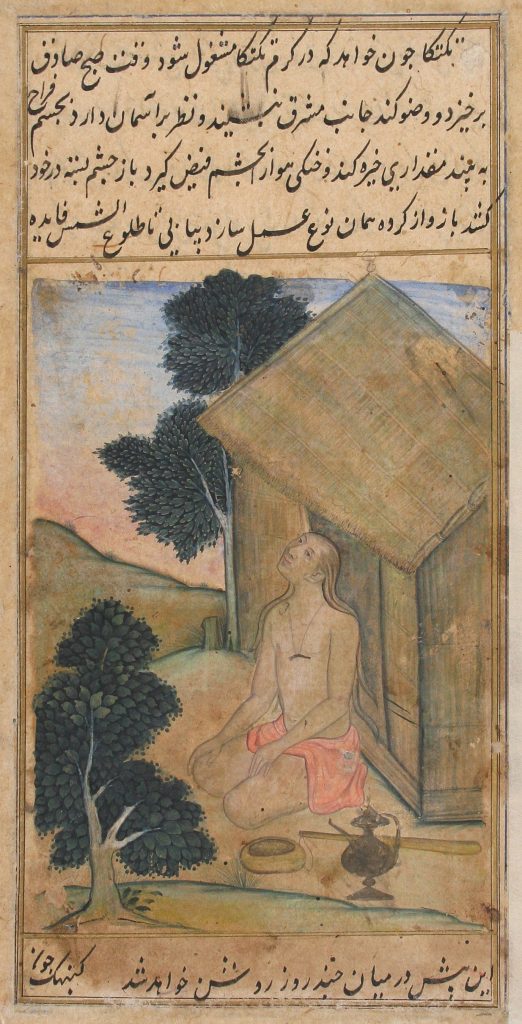
- The recollection of tiktikā [no. 16]. When the wayfarer wishes to perform the tiktikā practice, at the time of the true dawn he arises and performs ablutions [wuḍū’, for Muslim prayer], sits facing the east, and gazes at heaven. He gazes open-eyed, which makes part of the eye dazzled, and obtains the bounty of the coolness of the air by the eye. Again closing the eye, he takes it in; again opening it up, he practices that very kind, in sequence, until sunrise. The numerous benefits of this will become evident after some days.
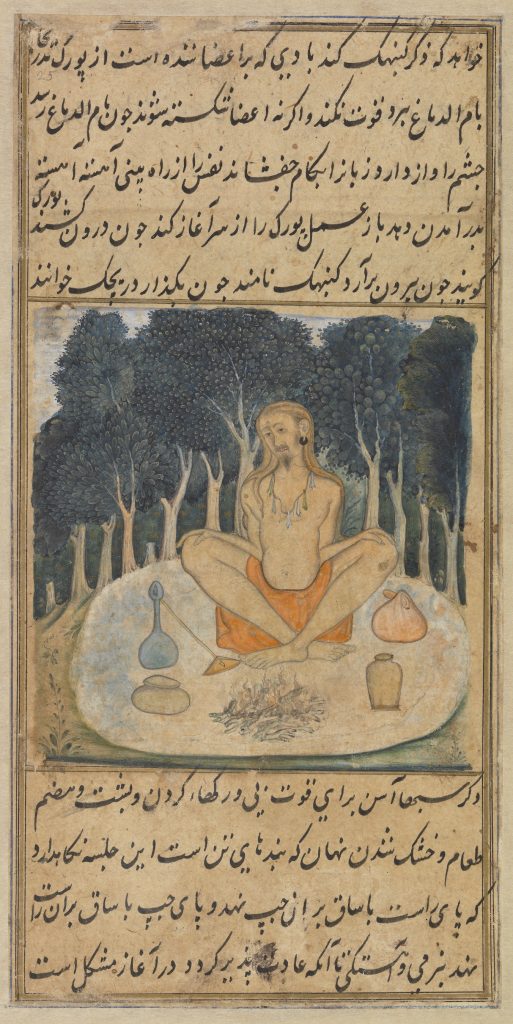
- The recollection of kumbhak [no. 17]. When one begins the kumbhak practice, one takes the wind that fills the limbs from the pūrak (?) to the base of the brain, without forcing it; otherwise, the limbs are broken. When one reaches the base of the brain, one opens the eyes, attaching the tongue to the palate, gradually letting the breath escape by the nostrils. One then starts the pūrak practice from the beginning; when one inhales, they call it pūrak. When one exhales,21 they term it kumbhak. When one lets it go, they call it rījak (?).
21 Other MSS say, when one holds it.

- The recollection of the sahasa āsana [no. 18], for the strengthening of the foot, the veins, the shoulders, the back, the digestion of food, and the drying out of hidden moistures that are in the chain of the body. One holds this position, placing the right foot and shin on the left thigh and holding the left foot and shin on the right thigh, slowly and gently, until it becomes a habit, though it is difficult in the beginning. One holds the back straight, and both hands under the knees, holding the arms straight, with the hair sticking to the body. Whoever arrives at this station has three qualities appear in him: little sleep, little food, and little speech.22
22 This formula in Persian (kam khuftan, kam khwurdan, kam guftan) has a precise rhyming equivalent in Arabic (qillat al-manām, qillat al-ṭa`ām, qillat al-kalām), which is well known in early Sufi texts.

- The recollection of the chakra āsana [no. 19]. One sits crosslegged as mentioned, and places the right hand on the back of the neck toward the left shoulder blade, and the left hand toward the right shoulder blade. One holds the back upright and straight, turning the head in all four directions. In the heart one says the same recollection.23 When one wishes to remain still, one places both hands on the knees and holds both legs upright, never neglecting the recollection. When one attains stability in this, contemplation of the hidden is attained, and longing overcomes action. Leprosy, gangrene, hemorrhoids, and consumption, which are all incurable, are eliminated. Other illnesses are prevented by the latter posture. These are among their [the Jogis’] experiences.
23 Some MSS say, “that is, the recollection of alakh.”
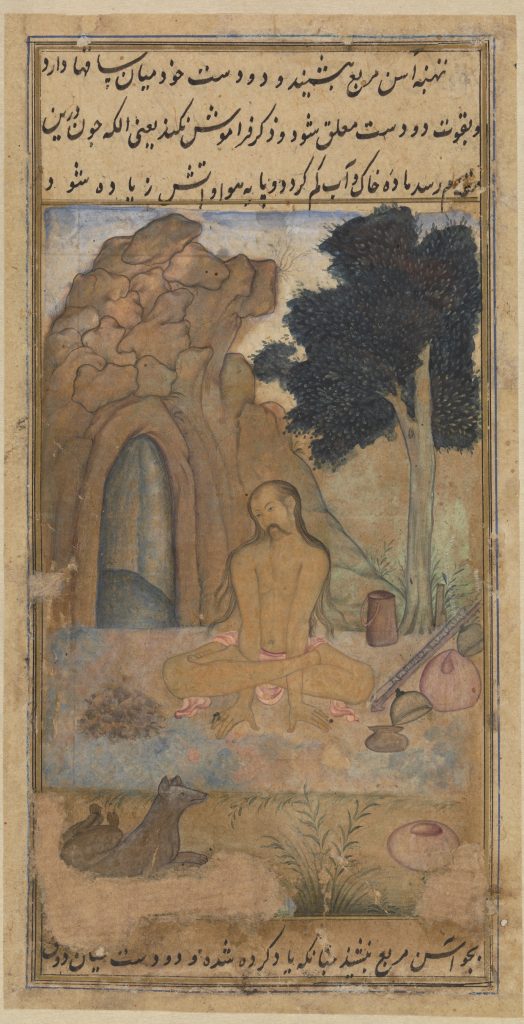
- The recollection of the thambha āsana [no. 20]. One sits crosslegged holding both one’s hands in between the shins, so that one is suspended by the strength of both hands. One does not forget the recollection.24 When one reaches this station, the matter of earth and water becomes reduced, and the matter of air and fire is increased.
24 Some MSS say, “that is, alakh.”

- The recollection of the vajra āsana [no. 21]. One sits crosslegged, just as has been recalled. One introduces both hands in between the shin and the thigh and bows down, placing both hands on the neck so that the fingers of both hands are intertwined on the neck. One does not forget the recollection. When one reaches this station, one leaves fear of demons, jinn, fairies, humans, and animals. If heaven fell on earth, it would not be a problem. This is a mighty rank.

- The recollection of the sun āsana [no. 22]. First, one clenches both fists and places them on the earth, placing the toes of the right foot on the right elbow and the toes of the left foot on the left elbow. One performs the recollection. Whoever reaches this station becomes capable of flight and becomes one of the spiritual entities – and God knows best.
Map
The map includes the locations where exhibition artworks were created as well as sites mentioned in the scholarly essays in the catalogue.
All locations are approximate.
Resources and Selected Bibliography
Exhibition Catalogue
Yoga: The Art of Transformation | Catalogue
Related Exhibitions
Strange and Wondrous: Prints of India from the Robert J. Del Bontà Collection
Perspectives: Rina Banerjee
Related Collection
Collections: South Asian and Himalayan Art
Symposium
Medical Yoga Symposium: Modern Yoga
Yoga and Visual Culture Symposium videos
Suggested Readings
Chapter 4 of the Bahr al-hayat, by Muhammad Ghawth Gwaliyari
Yogic Identities: Tradition and Transformation by James Mallinson
Map
Alter, Joseph. Yoga in Modern India: The Body between Science and Philosophy. Princeton: Princeton University Press, 2004.
Behl, Aditya. Qutban Suhravardī’s Mirigāvatī: The Magic Doe, edited by Wendy Doniger. Oxford: Oxford University Press, 2012.
Buhnemann, Gudrun. Eighty-four Asanas in Yoga: A Survey of Traditions with Illustrations. New Delhi: D. K. Printworld, 2007.
Chapple, Christopher Key. Reconciling Yogas: Haribhadra’s Collection of Views on Yoga. Albany: State University of New York Press, 2003.
———. “The Sevenfold Yoga of the Yogavasishta.” In Yoga in Practice, edited by David Gordon White, pp. 117–33. Princeton: Princeton University Press, 2011.
Childers, Hope. “The Visual Culture of Opium in British India.” PhD diss., University of California, Los Angeles, 2011.
Davidson, Ron. Indian Esoteric Buddhism: A Social History of the Tantric Movement. New York: Columbia University Press, 2003.
De Michelis, Elizabeth. “A Preliminary Survey of Modern Yoga Studies.” Asian Medicine 3, no. 1 (2007): pp. 1–19.
———. History of Modern Yoga: Patanjali and Western Esotericism. London: Continuum, 2005.
Dehejia, Vidya. The Sensuous and the Sacred: Chola Bronzes from South India. New York: American Federation of Arts, 2002.
———. Yoginī, Cult and Temples: A Tantric Tradition. New Delhi: National Museum, 1986.
Diamond, Debra. Garden and Cosmos: The Royal Paintings of Jodhpur. Washington, DC: Arthur M. Sackler Gallery, 2008.
———. “Occult Science and Bijapur’s Yoginis.” In Indian Painting: Themes, History and Interpretations (Essays in Honour of B. N. Goswamy), edited by Mahesh Sharma. Ahmedabad: Mapin Publishing, forthcoming.
Ernst, Carl W. “Accounts of Yogis in Arabic and Persian Historical and Travel Texts.” Jerusalem Studies in Arabic and Islam 33 (2008), pp. 409–26.
———. “Being Careful with the Goddess: Yoginis in Persian and Arabic Texts.” In Performing Ecstasy: The Poetics and Politics of Religion in India, edited by Pallabi Chakrabarty and Scott Kugle, pp. 189–203. Delhi: Manohar, 2009.
———. “Situating Sufism and Yoga.” Journal of the Royal Asiatic Society 15, no. 1 (2005), pp. 15–43.
———. “The Islamization of Yoga in the Amrtakunda Translations.” Journal of the Royal Asiatic Society, ser. 3, vol. 13, no. 2 (2003), pp. 199–226.
Feuerstein, Georg. The Yoga Tradition: Its History, Literature, Philosophy and Practice. Prescott, AZ: Hohm, 2001.
Flood, Gavin. Body and Cosmology in Kashmir Saivism. San Francisco: Mellen Research University Press, 1993.
Hatley, Shaman. “Goddesses in Text and Stone: Temples of the Yoginīs in Light of Tantric and Purānic Literature.” In History and Material Culture in Asian Religions, edited by Benjamin Fleming and Richard Mann. London: Routledge, 2013.
Kaimal, Padma. Scattered Goddesses: Travels with the Yoginis. Ann Arbor, MI: Association of Asian Studies, 2011.
King, Richard. Orientalism and Religion: Postcolonial Theory, India and the “Mystic East.” London: Routledge, 1999.
Kramrisch, Stella. Manifestations of Shiva. Philadelphia: Philadelphia Museum of Art, 1981.
Linrothe, Rob. “Siddhas and Srīśailam, ‘Where All Wise People Go.’” In Holy Madness: Portraits of Tantric Siddhas, edited by Rob Linrothe, pp. 125–43. New York and Chicago: Rubin Museum of Art and Serindia Publications, 2006.
Mallinson, James. “Haṭha Yoga.” In Brill’s Encyclopedia of Hinduism, vol. 3, edited by Knut A. Jacobsen, pp. 770–81. Leiden: Brill, 2011.
———. “Nāth Saṃpradāya.” In Brill’s Encyclopedia of Hinduism, vol. 3, edited by Knut A. Jacobsen, pp. 407–28. Leiden: Brill, 2011.
———. “Śāktism and Haṭhayoga.” In The Śākta Traditions. Oxford: Oxford University Press, 2013.
———. The Gheranda Samhita: The Original Sanskrit and an English Translation. Woodstock, NY: YogaVidya.com, 2004.
———. The Khecarīvidyā of Ādhinātha: A Critical Edition and Annotated Translation of an Early Text of Haṭhayoga. London: Routledge, 2007.
Meister, Michael. “Art and Hindu Asceticism: Śiva and Vishnu as Masters of Yoga.” In Explorations in Art and Archaeology of South Asia: Essays Dedicated to N. G. Majumdar, edited by Debala Mitra, pp. 315–21. Calcutta: Directorate of Archaeology and Museums, Government of West Bengal, 1996.
———. “Image Iconopraxis and Iconoplasty in South Asia.” Anthropology and Aesthetics 51 (2007), pp. 13–32.
O’Flaherty, Wendy Doniger. Dreams, Illusion, and Other Realities. Chicago: University of Chicago Press, 1984.
Pinch, William. Warrior Ascetics and Indian Empires. Cambridge: Cambridge University Press, 2006.
Ranjan, Neena. Vishvarupa: Paintings on the Cosmic Form of Krishna-Vasudeva. New Delhi: Aryan Books International, 2008.
Samuel, Geoffrey. The Origins of Yoga and Tantra: Indic Religions to the Thirteenth Century. Cambridge: Cambridge University Press, 2008.
Sanderson, Alexis. “Saivism and the Tantric Traditions.” In The World’s Religions, edited by S. Sutherland, et al. London: Routledge, 1988.
Sears, Tamara I. “Constructing the Guru: Ritual Authority and Architectural Space in Medieval India.” The Art Bulletin 90, no. 1 (2008), pp. 7–29.
———. “Encountering Ascetics On and Beyond the Indian Temple Wall.” In History and Material Culture in Asian Religions, edited by Benjamin Fleming and Richard Mann. London: Routledge, 2013.
Singleton, Mark. Yoga Body: The Origins of Modern Posture Practice. Oxford: Oxford University Press, 2010.
Urban, Hugh. Tantra: Sex, Secrecy, Politics, and Power in the Study of Religion. Berkeley: University of California Press, 2003.
Vivekananda, Swami. Rāja Yoga, or conquering the internal nature: Lectures delivered in New York, winter of 1895–6. New York: Longmans, Green, 1896.
White, David Gordon. The Alchemical Body: Siddha Traditions in Medieval India. Chicago: University of Chicago Press, 2007.
———. Kiss of the Yoginī: “Tantric Sex” in Its South Asian Contexts. Chicago: University of Chicago Press, 2006.
———. Sinister Yogis. Chicago: University of Chicago Press, 2009.
———. Tantra in Practice. Princeton: Princeton University Press, 2000.
———. Yoga in Practice. Princeton: Princeton University Press, 2012.
Reviews
When the ‘Warrior Pose’ Was for Warriors
The art of yoga
Sackler Gallery Explores History of Yoga In New Exhibit
If you’re looking for the one true yoga, you’re out of luck
Yoga: The Art of Transformation’ art review
Sackler’s ‘Art in Context’ let’s participants practice yoga in the gallery
Eons Before the Yoga Mat Became Trendy; ‘Yoga: The Art of Transformation’ at Sackler Gallery
Exercise of Imagination
Under the Spell of Yoga
The art of yoga
Keep Exploring
-

Perspectives: Rina Banerjee
July 6, 2013 to June 8, 2014
-

Strange and Wondrous: Prints of India from the Robert J. Del Bontà Collection
October 19, 2013 to January 5, 2014
Detail, Vishnu Vishvarupa; India, Rajasthan, Jaipur, ca. 1800–1820; Opaque watercolor and gold on paper, 38.5 x 28 cm; Victoria and Albert Museum, London, Given by Mrs. Gerald Clark, IS.33-2006.
- Jump To...




